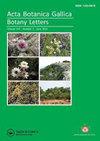Phylogeny of Mediterranean Lathyrus species using Inter Simple Sequence Repeats markers
引用次数: 16
Abstract
Abstract The genus Lathyrus constitutes an important phytogenetic patrimony as a source of traditional foodstuffs in Tunisia. An Inter-Simple Sequence Repeats (ISSR) technique was employed to assess genetic diversity and relationships of seven Mediterranean species of the genus Lathyrus belonging to four sections (Lathyrus, Clymenum, Nissolia and Aphaca). The molecular characterization and fingerprint identification of 11 populations representing the Lathyrus species were conducted using 11 ISSR primers (seven 3’ anchored primers and four non-anchored primers). A total of 261 polymorphic markers have been successfully generated, ranging between 400 and 3000 base pairs, with a mean of 23.72 bands/primer. The percentage of polymorphic bands for these species was 98.12%. The ISSR technique was able to characterize and differentiate between the different studied genotypes of the Lathyrus species. Genetic distance within and between populations was estimated by calculating the similarity index. The similarity indices ranged from 0.251–0.741, with a mean of 0.386. Our data provide evidence of high molecular polymorphism, showing that both wild and cultivated species forms constitute an important pool of diversity. Despite the large distant geographical origin site, the accessions per species issued from different geographical origins are relatively related. Moreover, the genetic similarity tree showed that the two species L. sativus and L. cicera are similar showing that L. sativus may be derived from L. cicera, whereas the principal component analysis showed a clear divergence of the L. ochrus population belonging to section Clymenum from the other populations. Furthermore, L. ochrus appears to be closer to L. aphaca and L. nissolia than to the other studied species belonging to section Lathyrus.利用简单序列重复序列间标记研究地中海沙蚕种的系统发育
摘要:草属构成了重要的植物遗传遗产,是突尼斯传统食品的来源。采用简单序列重复序列(ISSR)技术对地中海地区7种Lathyrus属植物(Lathyrus、Clymenum、Nissolia和Aphaca)的遗传多样性和亲缘关系进行了分析。利用11条ISSR引物(7条3 '锚定引物和4条非锚定引物)对11个地瓜属植物居群进行了分子表征和指纹鉴定。共获得261个多态性标记,数量在400 ~ 3000个碱基对之间,平均23.72个条带/引物。多态带比例为98.12%。ISSR技术能够表征和区分所研究的不同基因型的石菖蒲。通过计算相似指数估计群体内和群体间的遗传距离。相似度指数范围为0.251 ~ 0.741,平均值为0.386。我们的数据提供了高分子多态性的证据,表明野生和栽培物种形式构成了一个重要的多样性池。尽管地理源区遥远,但不同地理源区的种数相对相关。此外,遗传相似树分析表明,L. sativus和L. cicera两个物种相似,表明L. sativus可能来源于L. cicera,而主成分分析表明,L. ochrus属于Clymenum section的群体与其他群体存在明显的差异。此外,相对于其他被研究的Lathyrus科的物种,L. ochrus似乎更接近L. aphaca和L. nissolia。
本文章由计算机程序翻译,如有差异,请以英文原文为准。
求助全文
约1分钟内获得全文
求助全文

 求助内容:
求助内容: 应助结果提醒方式:
应助结果提醒方式:


